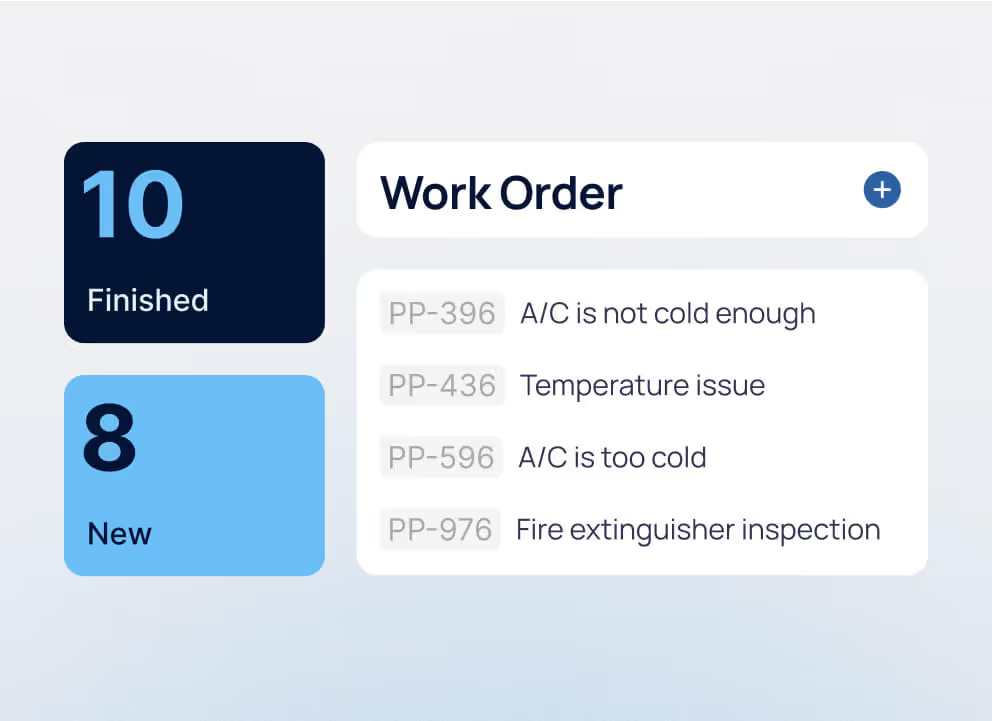The Power of EAM / CMMS Integrations
The Power of EAM / CMMS Integrations
In this post
%20(1).avif)
1
2
3
The Power of EAM / CMMS Integrations
Unleash the full potential of your CMMS with enhanced efficiency and connectivity through Universal Interfaces and APIs. Leverage integrations to achieve seamless business operations and maximum efficiency.
CMMS solutions have become vital tools for managing maintenance activities, asset tracking, and improving overall productivity. As organizations explore different CMMS options to implement, maintenance teams should consider the solution’s integration capabilities. To unleash the full potential of CMMS / EAM software ,integrating it with existing business software through APIs (Application Programming Interfaces) or a set of Universal Interfaces is the best way forward to achieving the greatest value out of your systems.
From centralized data to streamlined workflows to increased collaboration, there are numerous benefits of leveraging Universal Interfaces and APIs with your chosen CMMS.
The Importance of Quality Data Integration and Extraction with a CMMS
Integrating and extracting quality data is imperative for accurate analysis and data-driven decision making. With Data drives decisions and with the ability to
Centralized Data Repository: Consolidate extracted data from various integration sources within the CMMS solution. Through this centralized data repository, maintenance teams can access a single source of truth for maintenance-related information. With this comprehensive dataset, they can make informed decisions, perform predictive maintenance effectively, and ensure data integrity.
Streamlined Data Flow: Ensure streamlined data flow by integrating a CMMS with existing business software. By breaking down data silos, organizations can facilitate the seamless exchange of relevant information across systems. This eliminates the need for manual data entry, reduces duplication, and minimizes the chances of data discrepancies or inconsistencies.
Advanced Analytics and Insights: Get advanced analytics and insights by integrating data from multiple systems. CMMS integrations empower organizations to leverage machine learning algorithms and artificial intelligence to analyze maintenance data, identify patterns, and predict failure probabilities. This proactive approach helps organizations minimize downtime, optimize resource allocation maximize the lifespan of assets.
Seamless Regulatory Compliance: Ensure that maintenance activities align with industry standards and regulations by employing CMMS integrations with regulatory compliance software. Data integration provides real-time records of maintenance activities, ensuring accurate and compliant documentation. This mitigates the risk of penalties and legal complications, fostering a culture of reliability and trust.
Integrate with WebTMA and See the Results
Our commitment to open architecture means that you can connect WebTMA with your preferred business systems, maximizing the full potential of your existing software. Whether you need to integrate with an ERP, asset management, or regulatory compliance software, our flexible Platform APIs and Universal Interfaces ensure a seamless flow of data, streamlined workflows, and enhanced collaboration.
Organization scan optimize their return on investment and drive operational excellence in their maintenance management practices by integrating WebTMA into their software ecosystem. Schedule a demo to learn how to optimize your operational processes with WebTMA, an open and configurable maintenance management solution.
- Break down data silos and align teams with a unified maintenance ecosystem.
- Support long-term planning with cross-platform insights into assets, budgets, and performance.
- Scale smarter by building an integrated tech stack tailored to your operations.

Download the eBook now
You’re all set!
Your eBook is on its way to your inbox. We hope it brings fresh insights and practical takeaways to help you get more from your maintenance operations.
Explore related resources
.avif)
.svg)
The Power of EAM / CMMS Integrations
Unleash the full potential of your CMMS with enhanced efficiency and connectivity through Universal Interfaces and APIs. Leverage integrations to achieve seamless business operations and maximum efficiency.
CMMS solutions have become vital tools for managing maintenance activities, asset tracking, and improving overall productivity. As organizations explore different CMMS options to implement, maintenance teams should consider the solution’s integration capabilities. To unleash the full potential of CMMS / EAM software ,integrating it with existing business software through APIs (Application Programming Interfaces) or a set of Universal Interfaces is the best way forward to achieving the greatest value out of your systems.
From centralized data to streamlined workflows to increased collaboration, there are numerous benefits of leveraging Universal Interfaces and APIs with your chosen CMMS.
The Importance of Quality Data Integration and Extraction with a CMMS
Integrating and extracting quality data is imperative for accurate analysis and data-driven decision making. With Data drives decisions and with the ability to
Centralized Data Repository: Consolidate extracted data from various integration sources within the CMMS solution. Through this centralized data repository, maintenance teams can access a single source of truth for maintenance-related information. With this comprehensive dataset, they can make informed decisions, perform predictive maintenance effectively, and ensure data integrity.
Streamlined Data Flow: Ensure streamlined data flow by integrating a CMMS with existing business software. By breaking down data silos, organizations can facilitate the seamless exchange of relevant information across systems. This eliminates the need for manual data entry, reduces duplication, and minimizes the chances of data discrepancies or inconsistencies.
Advanced Analytics and Insights: Get advanced analytics and insights by integrating data from multiple systems. CMMS integrations empower organizations to leverage machine learning algorithms and artificial intelligence to analyze maintenance data, identify patterns, and predict failure probabilities. This proactive approach helps organizations minimize downtime, optimize resource allocation maximize the lifespan of assets.
Seamless Regulatory Compliance: Ensure that maintenance activities align with industry standards and regulations by employing CMMS integrations with regulatory compliance software. Data integration provides real-time records of maintenance activities, ensuring accurate and compliant documentation. This mitigates the risk of penalties and legal complications, fostering a culture of reliability and trust.
Integrate with WebTMA and See the Results
Our commitment to open architecture means that you can connect WebTMA with your preferred business systems, maximizing the full potential of your existing software. Whether you need to integrate with an ERP, asset management, or regulatory compliance software, our flexible Platform APIs and Universal Interfaces ensure a seamless flow of data, streamlined workflows, and enhanced collaboration.
Organization scan optimize their return on investment and drive operational excellence in their maintenance management practices by integrating WebTMA into their software ecosystem. Schedule a demo to learn how to optimize your operational processes with WebTMA, an open and configurable maintenance management solution.
- Break down data silos and align teams with a unified maintenance ecosystem.
- Support long-term planning with cross-platform insights into assets, budgets, and performance.
- Scale smarter by building an integrated tech stack tailored to your operations.

Register for your free webinar
You’re all set!
Your webinar is on its way to your inbox. We hope it brings fresh insights and practical takeaways to help you get more from your maintenance operations.
Explore related resources
.avif)
.svg)
The Power of EAM / CMMS Integrations
The Power of EAM / CMMS Integrations
The Power of EAM / CMMS Integrations

CMMS solutions have become vital tools for managing maintenance activities, asset tracking, and improving overall productivity. As organizations explore different CMMS options to implement, maintenance teams should consider the solution’s integration capabilities. To unleash the full potential of CMMS / EAM software ,integrating it with existing business software through APIs (Application Programming Interfaces) or a set of Universal Interfaces is the best way forward to achieving the greatest value out of your systems.
From centralized data to streamlined workflows to increased collaboration, there are numerous benefits of leveraging Universal Interfaces and APIs with your chosen CMMS.
The Importance of Quality Data Integration and Extraction with a CMMS
Integrating and extracting quality data is imperative for accurate analysis and data-driven decision making. With Data drives decisions and with the ability to
Centralized Data Repository: Consolidate extracted data from various integration sources within the CMMS solution. Through this centralized data repository, maintenance teams can access a single source of truth for maintenance-related information. With this comprehensive dataset, they can make informed decisions, perform predictive maintenance effectively, and ensure data integrity.
Streamlined Data Flow: Ensure streamlined data flow by integrating a CMMS with existing business software. By breaking down data silos, organizations can facilitate the seamless exchange of relevant information across systems. This eliminates the need for manual data entry, reduces duplication, and minimizes the chances of data discrepancies or inconsistencies.
Advanced Analytics and Insights: Get advanced analytics and insights by integrating data from multiple systems. CMMS integrations empower organizations to leverage machine learning algorithms and artificial intelligence to analyze maintenance data, identify patterns, and predict failure probabilities. This proactive approach helps organizations minimize downtime, optimize resource allocation maximize the lifespan of assets.
Seamless Regulatory Compliance: Ensure that maintenance activities align with industry standards and regulations by employing CMMS integrations with regulatory compliance software. Data integration provides real-time records of maintenance activities, ensuring accurate and compliant documentation. This mitigates the risk of penalties and legal complications, fostering a culture of reliability and trust.
Integrate with WebTMA and See the Results
Our commitment to open architecture means that you can connect WebTMA with your preferred business systems, maximizing the full potential of your existing software. Whether you need to integrate with an ERP, asset management, or regulatory compliance software, our flexible Platform APIs and Universal Interfaces ensure a seamless flow of data, streamlined workflows, and enhanced collaboration.
Organization scan optimize their return on investment and drive operational excellence in their maintenance management practices by integrating WebTMA into their software ecosystem. Schedule a demo to learn how to optimize your operational processes with WebTMA, an open and configurable maintenance management solution.


Related resources
Related resources
You’ve seen what’s possible—connect with us to learn how TMA Systems can support your goals beyond the event.
You’ve read the insights, now see how TMA Systems helps teams put them into practice.
From ideas to impact
You’ve read the insights, now see how TMA Systems helps teams put them into practice.
From screen to solution
You’ve watched what’s possible, now see how TMA Systems works for your organization.
From insight to implementation
You’ve explored the strategies, now see how we can bring them to life across your real facilities.
From insight to implementation
You’ve explored the strategies, now see how we can bring them to life across your real facilities.




.svg)


.avif)





